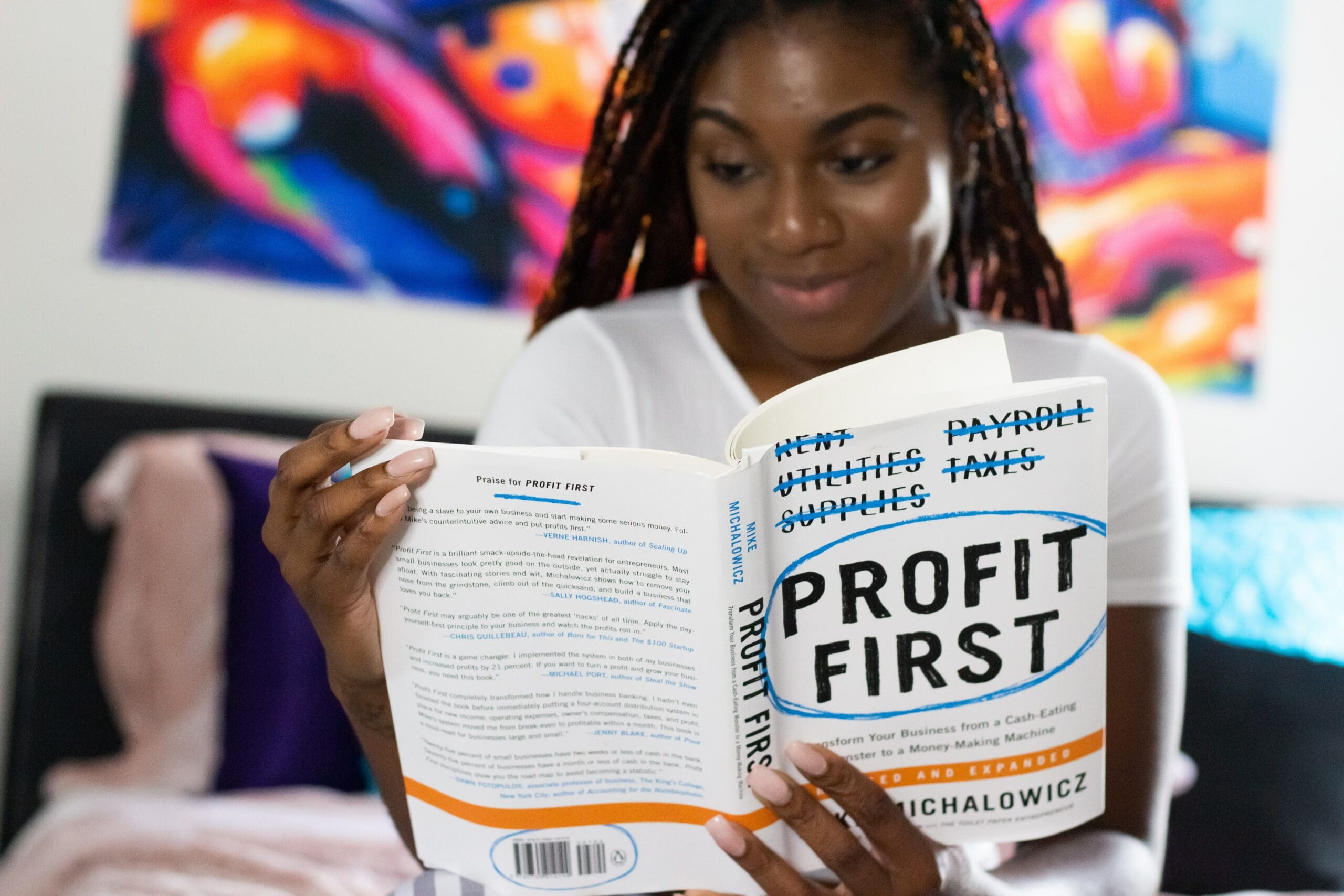As much as I wish I could just design all day and never have to worry about the financial elements of business ownership, I know that if I want Honey to grow then I gotta get my head in the accounting game. With that being said, I’ve recently taken a hive dive into a book called Profit First by Mike Michalowicz*. My financial advisor (shout out, Garrett) recommended it. I have felt surprisingly empowered and excited to take control of the financial health of my hive. Who even am I?!
I’ve spent—no exaggeration—years trying to find a guide for HOW MUCH TO PAY MYSELF. It felt arbitrary and weird to just transfer over a few thousand here and there to pay my personal bills but that’s what I did for years. When the business didn’t earn money, neither did I. In addition, I know so many other business owners that operate the same way. They either don’t pay themselves a livable wage or they feel pressured to grow their expenses to match their business britches…a bigger team, the fancy office, meals on me, type of energy.
So you know I love to share hot takes with other businesses, and while I suggest giving it a read, I also know that busy bees can benefit from the cliff notes.
*here’s the boring legal disclaimer below*
[Honey Creative and its affiliates do not provide tax, legal, or accounting advice. This material has been prepared for informational purposes only, and is not intended to provide, and should not be relied on for, tax, legal or accounting advice. You should consult your own tax, legal, and accounting advisors before engaging in any transaction.]
What is the Profit First method?
First, the concept of Profit First differs from traditional profit formulas that deduct expenses from sales and leave the remaining amount as profit:
The Traditional Method:
Revenue – Expenses – Taxes* – Your Wages = Profit
(Tbh there wasn’t sh*t left after all of that so pause for comedic relief because )
Instead, this method says that business owners should take a profit before paying expenses. Yep, ya heard that right.
In a nerdy nutshell, Mike is advocating to slowly begin retaining a percentage (5%) in the business as profit for the health and wealth of the business and its owners. In addition, he also recommends businesses keep their operational expenses under a certain percentage of their overall revenue. For businesses that earn under $250K annually, he recommends keeping your expenses or Op Ex under 30% of your revenue.
Are you a good candidate for Profit First?
If you find yourself considering the following things then you’re gonna want to head to Amazon and purchase the book asap.
- How much profit am I making? Worse… am I even making a profit??
- I’m definitely not paying myself enough. Am I?
- Am I spending too much on coffee and custom koozies with my face on them?
- Paying taxes really f*cking sucks. I never feel prepared and I’m always surprised by how much I owe!
Why use Profit First?
- To gain more immediate insight just by logging into your accounts rather than requesting access from your CPA or bookkeeper
- Finally pay yourself well
- Save for downturns in revenue by keeping a Profit buffer to draw from in case of emergency
- Consolidate your expenses and review each one to determine if they’re actually helpful or just another line item
- Project your growth, taxes, and account for a salary increase as your business expands
How do I use Profit First?
Hives like yours will set up five separate bank accounts:
- Income – This is where you get paid. Where all invoices go to thrive.
- Profit – This is where you keep profit generated each month. Fifty percent of the accumulated amount is drawn from by the business owners quarterly as bonuses, office parties, or whatever you wish to spend it on. But the other 50% stays put.
- Tax – An account that keeps taxes paid by the company on its income.
- Operating Expenses (OpEx) – this is where you keep money needed to run your business.
- Owners Compensation – this is where you keep YOUR money that will be paid to the owners of the company.
Don’t overcomplicate it. These don’t have to be at separate banks or a .001% earning savings account, just keep it simple with checking accounts at your current bank and give it a custom name.
For Honey, I opened up two new accounts (for a grand total of 3 checking accounts) and use a business credit card (for the points!) as my operating expense account. My owner’s compensation account is via Gusto (where I pay myself).
But how much should I be allocating?
For businesses that earn under $250K annually, the recommended (eventual! Not overnight percentages) are as follows:
| Profit 5% |
| Owners Pay 50% |
| Tax 15% |
| Operational Expenses 30% |
Review your last year’s taxes to calculate your current percentages standards and determine just how much you need to trim or beef up.
- Determine your ‘real revenue’ number: this is your gross income minus materials and cost of goods and/or contract labor.
- Calculate your Owner’s Pay: Multiply your ‘real revenue’ by 50% (for example, $100K X .50= Owner’s Pay Target of $50K) to get the amount you should have spent in the given category.
- Repeat for the other four categories.
- Compare your Target Amounts with what you actually spent: Subtract the Target Amounts from what you actually spent. Some of these might be in the negative, but that’s ok! For example, if the business earned $100K, but I only paid myself $40K. I would need to increase my personal salary by $10K.
Of course, the most eye-opening of this exercise for most is the operational expenses. When I ran Honey’s numbers, I overspent in this category by nearly $11K. I thought but what did I even buy?! There’s no shame in the past, only better goals for the future. I acknowledged my shortcomings and am committed to revisiting every expense to determine if it’s actually crucial to run my business. Meanwhile, I didn’t pay myself enough given the overall success the business had. This. Is. So. Common.
Lastly, Michalowitz advises that business owners transfer funds from the first ‘Income’ account twice per month based on earnings, on the 10th and 25th. Or honestly do it once a month, whatever works on a regular basis!
But start slow, Rome wasn’t built in a day so each month incrementally increase your percentage allocated in each category (up or down depending on your Target Amount discrepancy) until you hit your Target Percentage.
To simplify, I created a little quarterly spreadsheet to help you calculate each account and hopefully make more money for you and your business! Feel free to edit it to be a monthly sheet if you’d prefer! Download the freebee here and let me know what you think.
Final Thoughts
You don’t have to offer more services to stretch yourself thin or have a ‘big’ business to have a successful one. You deserve to pay yourself a competitive salary that’s indicative of your experience and commitment to the company! Be sure to actually read Profit First (I think every business owner should!).
*Indicates an affiliate link





